This question is a follow-up to Select first rank if RANK()+1 overflows with JOINS
The scenario
I have a bunch of predefined messages that my Discord and Twitch bots send to dedicated channels every 30 minutes in round-robin only if X messages where sent by other users between each of the bot's messages. The round-robin is independant from one channel to another.
SQL tables
CREATE TABLE `loop_msg` (
`msg_id` int(11) NOT NULL,
`content` varchar(2000) CHARACTER SET utf8mb4 COLLATE utf8mb4_unicode_ci NOT NULL
) ENGINE=InnoDB DEFAULT CHARSET=latin1;
INSERT INTO `loop_msg` (`msg_id`, `content`) VALUES
(2, 'Content 2'),
(3, 'Content 3'),
(4, 'Content 4'),
(6, 'Content 6'),
(7, 'Content 7'),
(8, 'Content 8');
CREATE TABLE `loop_msg_status` (
`channel_id` bigint(20) NOT NULL,
`msg_id` int(11) NOT NULL DEFAULT 0,
`inbetween` int(11) NOT NULL DEFAULT 0
) ENGINE=InnoDB DEFAULT CHARSET=latin1;
INSERT INTO `loop_msg_status` (`channel_id`, `msg_id`, `inbetween`) VALUES
(123456789012345671, 2, 10),
(123456789012345672, 4, 30),
(123456789012345673, 6, 10),
(123456789012345674, 6, 0),
(123456789012345675, 6, 15),
(123456789012345676, 8, 10);
ALTER TABLE `loop_msg`
ADD PRIMARY KEY (`msg_id`);
ALTER TABLE `loop_msg_status`
ADD PRIMARY KEY (`channel_id`);
ALTER TABLE `loop_msg`
MODIFY `msg_id` int(11) NOT NULL AUTO_INCREMENT, AUTO_INCREMENT=9;
COMMIT;
The current query
Now, I need every 30 minutes to get every channel_id with inbetween >= 10 from msg_loop_status, the next message's content from loop_msg and the next msg_id from loop_msg as well since after posting the new message, I will UPDATE that channel_id's row with the new msg_id and set inbetween to 0. More specifically, if we're at the end of loop_message (with the highest msg_id), we need to restart the round-robin from the beginning (the lowest msg_id).
Here is what I currently have working:
WITH cte AS (
SELECT loop_msg.msg_id
, channel_id
, inbetween
, COALESCE(
LEAD(loop_msg.msg_id) OVER w1
, FIRST_VALUE(loop_msg.msg_id) OVER w1
) AS msg_id_next
, COALESCE(
LEAD(content) OVER w1
, FIRST_VALUE(content) OVER w1
) AS content_next
FROM loop_msg
LEFT JOIN loop_msg_status
ON loop_msg.msg_id = loop_msg_status.msg_id
WINDOW w1 AS (ORDER BY loop_msg.msg_id)
)
SELECT channel_id, content_next, msg_id, msg_id_next
FROM cte
WHERE channel_id IS NOT NULL AND inbetween >= 10
;
The problem
When multiples channels are at the same place (same msg_id for different channel_id in loop_msg_status), the ordering doesn't work correctly and the values for next_content and next_msg_id are the current values.
Expectations
Back to the basics: I have 1 channel_id in loop_msg_status where I send content from loop_msg in roundrobin every 30 minutes if inbetween >= 10. I store the msg_id of the sent content in loop_msg_status for that channel, and 30 minutes later, I query again to see where I'm at and post the next content. For example take this row:
channel_id: 123456789012345672
msg_id: 4
inbetween: 30
When doing my SELECT in msg_loop_status, since inbetween >= 10, this channel_id should be selected with the next msg_id that comes after 4 and its corresponding content from msg_loop. Because there isn't a msg_id=5, the next one is actually 6. So the output would be like this:
channel_id: 123456789012345672
next_msg_id: 6
next_content: Content 6
Applying that same logic to the whole example, I'm expecting the following output (the colums such as the current msg_id and content are not needed but can be added for the sake of the example for readability). 5 of the 6 channels have inbetween >= 10, so for each of these channels I need their next_msg_id and next_content as such:
channel_id | msg_id | next_msg_id | next_content
-----------------------------------------------
123456789012345671 | 2 | 3 | Content 3
123456789012345672 | 4 | 6 | Content 6
123456789012345673 | 6 | 7 | Content 7
123456789012345675 | 6 | 7 | Content 7
123456789012345676 | 8 | 2 | Content 2

